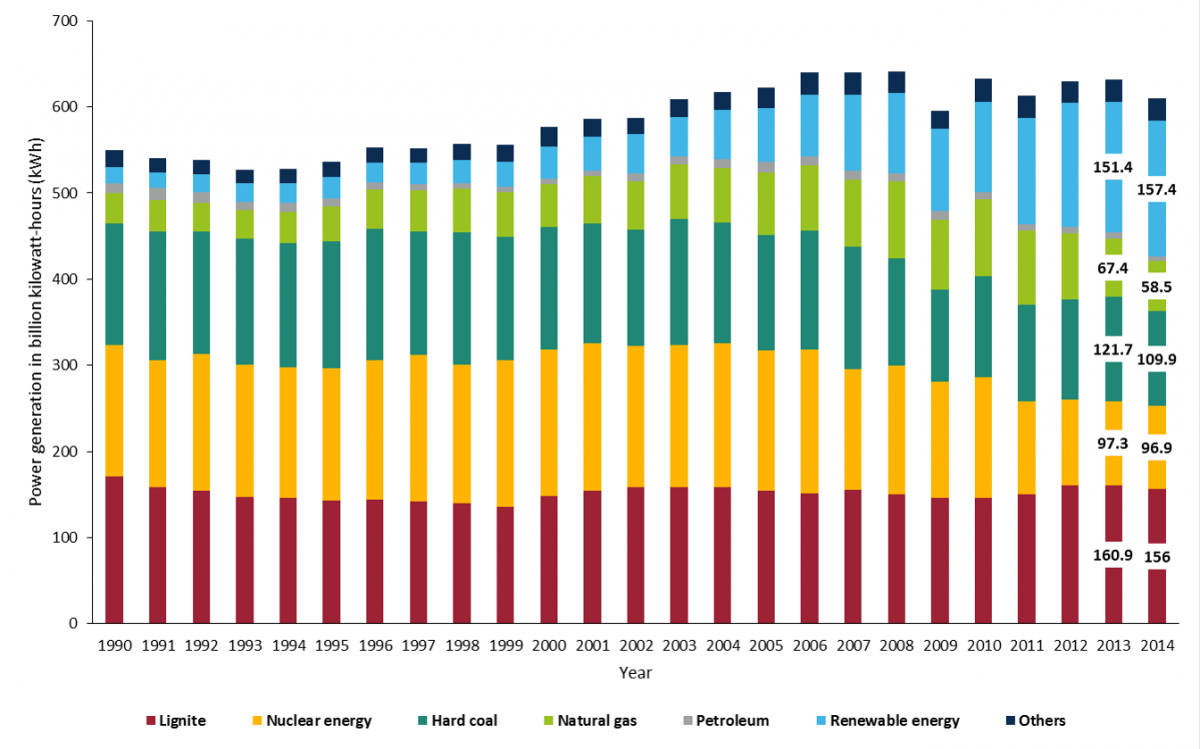I find it much more easy to talk in TWh rather than billion KWh
- Renewables 157,4 TWh
- Natural Gas 58.5 TWh
- Hard Coal 109.9 TWh
- Nuclear 96.9 TWh
- Lignite 156 TWh
- Total : 552 TWh
Broken down looks roughly like this
- Hydro 20 TWh / 13 %
- Wind 55 TWh / 34 %
- Biomass 50 TWh / 31 %
- PV 35 TWh / 22 %
source
... The German Federal Ministry for Economic affairs and Energy ...
... The German Federal Ministry for Economic affairs and Energy ...
The capacity factors of all the energy sources :
- Hydro 5 GW / 5 %
- Wind 40 GW / 42%
- Biomass 10 GW / 11 %
- PV 40 GW / 42 %
- Hydro 13 % generation > 5 % capacity (positive)
- Wind 34 % generation < 42% capacity (negative)
- Biomass 31% generation > 11 % capacity (positive)
- PV 22% generation < 42 % capacity (negative)
There's a clear negative correlation between capacity and generation. Because of this we may conclude that the push for renewable energy, in particular PV and wind power is a push for inefficiency. The math comes out in favour of dispatchable energy generation. Whereas hydro is maximized and Biomass is a combination of tree/crop/methane burning with lots of emissions tied to it...
The only thing that matters within this context is efficiency in terms of generation. Annual generation fluctuates slightly between 550 and 600 TWh. Wind and PV only account for 90 TWh. Hydropower is pretty much maxed out and Biomass is essentially perpetuating the carbon emissions. So we may conclude that Germany needs to expand PV and Wind in order to achieve their goals.
The Germans need to close a gap of 460~510 TWh. I am not feeling generous today and will go for the 600 TWh figure. Wind would be 9% of the total energy generation and solar 6%. Which paints quite a grim picture. The Germans would have to increase Wind tenfold or Solar 17 fold.
Capacities would look like this :
- Wind 400 GW
- Solar 680 GW
- Wind 200.000 2 MW units
- Solar 2.720.000.000 250 Watt superdeluxe units (< 2 billion 720 million)
The funny thing is that we only know that about 50GW's worth of PV panels are being produced annually. I always like to bring up the Topaz PV plant in these kinds of circumstances. The Topaz PV plant in California generates about 1.1 TWh annually and does this with nine million PV panels. I suppose that the owners of this plant have made an excellent cost analysis and have figured out that this gives the highest cost-benefit ratio. Something easily adopted across the world.
Suppose the Germans want to mimic the Topaz PV plant in order to build 680 GW's worth of capacity. It would take about 500 of these to get there. No square footage doesn't really interest me that much, I'm simply here to show you the numerical feasibility...
4.500.000.000 Topaz PV panels would be required to fuel Germany's current electricity needs. How reasonable is it to expect PV to be the driver behind the push for renewables, the German Energy Switch...
What about the area available and required for windmills :
Now I apologize, I'm a metric guy so I'm going to change it into square meters.
0.0930777 km2 / MW
We need 400 GW / 400.000 MW
0.093077 * 400.000 = 37.230 km2
Germany is 357.168 km2
Solar would require 32.000 km2
Solar would require 32.000 km2
Which means that more than 10% of all the land needs to be covered with Wind Turbines in order to satiate current demand, given the best case scenario I could find... What would the Germans have to say if all they could see across the entire horizon was wind turbines ?
Why do the Germans keep fooling themselves? Why do they shut down nuclear reactors? I mean all the graphs shared within this article come from a German Ministry... These people must be capable of doing some basic calculations. There are hundreds of people working on these graphs and calculations and yet no one stands up and mentions that the Germans are going in a direction that is numerically improbable and dare I say it contra-productive, dangerous, hazardous and wasteful.
What are we really doing?
We are discarding the one energy source that could solve all our issues, yet many of us are chasing unicorns (wind) and fairies (pv).
If the Germans really want to curb carbon emissions, they would be very wise to employ their technological fortitude in order to usher in a nuclear renaissance, rather than an ideological and supposedly green dead end.



The hoped for advantages of wind and solar are outweighed by the disadvantages of their being so unreliable, which forces inefficient use of the other means of generation. It also drives more use of fossil fuels.
ReplyDeleteWhy not safe, green, economic Thorium MSR energy?
ReplyDeleteKlaas,
DeleteI am a huge advocate for MSR, of any design! Terrestrial, Transatomic, Thorcon, Flibe, etc. etc.
I've even visited the MSR Symposium in Delft, did you get the chance to be there as well?